Press
Advanced Energy Materials Paper: Hybrid Polymer Electrolyte Encased Cathode Particles Interface-Based Core–Shell Structure for High-Performance Room Temperature All-Solid-State Batteries
Adv. Energy Mater., 2023, 13, 2202981. DOI: https://doi.org/10.1002/aenm.202202981
Pressemitteilung:
Bayreuther Forscher*innen entwickeln ultradünnen Festelektrolyten (Universität Bayreuth, 03.01.2023)
Press release:
Bayreuth researchers develop ultra-thin solid electrolyte (University of Bayreuth, 03.01.2023)
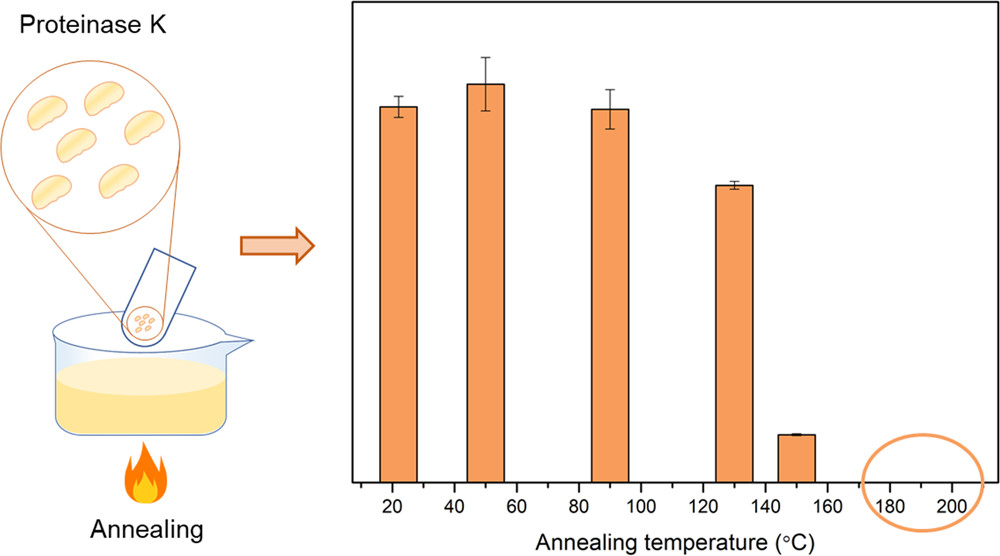
Biomacromolecules Paper: Investigation of the Thermal Stability of Proteinase K for the Melt Processing of Poly(l-lactide)
Biomacromolecules, 2022, 23, 4841-4850 DOI: 10.1021/acs.biomac.2c01008
Pressemitteilung:
Press release:
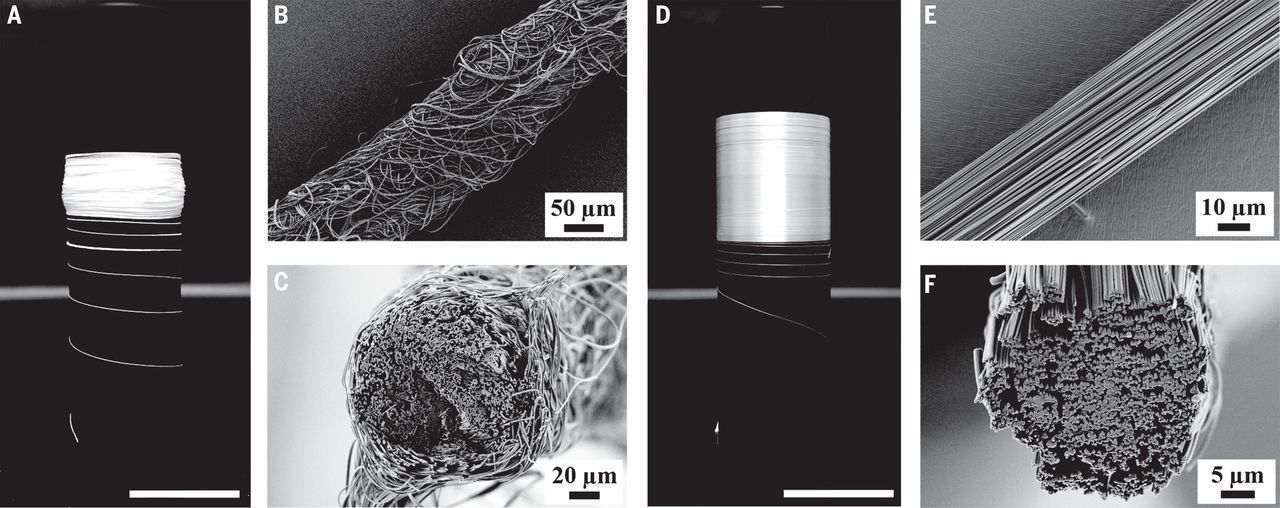
Science Paper: High strength in combination with high toughness in robust and sustainable polymeric materials
Science, 2019, 1376-1379 DOI: 10.1126/science.aay9033
Pressemitteilung:
Tages-/Wochenzeitungen:
- Internationales Forscherteam entwickelt Superfaser (Welt, 15.12.19)
- Wie Spinnenseide: Forscher entwickeln leichte Superfaser (Augsburger Allgemeine, 15.12.19)
Online-Portale:
- labonline.com.au
- newatlas.com
- innovations report
- scitechdaily.com
- Informationsdienst Wissenschaft (idw)
- Science Daily
- phys.org
- chemeurope.com
- c&en
- eurekalert.com
SFB 1357 „Mikroplastik“
Mikroplastik ist als zentrales Forschungsthema mit dem neu eingerichteten SFB 1357 „Mikroplastik“ etabliert worden. Die Makromolekulare Chemie der Universität Bayreuth wird ab dem 1.1.2019 für die nächsten 4 Jahre im Verbund des SFB ganz wesentlich zur Erforschung der Effekte von Mikroplastik auf Organismen, zur Wanderung von Mikroplastik durch unterschiedliche Umweltkompartimente, zur Bildung von Mikroplastik aus Makroplastik und zu möglichen Lösungsansätzen zur Vermeidung von Mikroplastik beitragen. Weitere Information zum Beitrag der Makromolekularen Chemie können von Prof. Andreas Greiner und Prof. Seema Agarwal erhalten werden.
- http://www.dfg.de/service/presse/pressemitteilungen/2018/pressemitteilung_nr_54/index.html
- https://stmwk.bayern.de/allgemein/meldung/6130/drei-bayerische-universitaeten-fuer-spitzenforschungsprojekte-ausgewaehlt.html
- https://www.uni-bayreuth.de/de/universitaet/presse/pressemitteilungen/2018/146-SFB-Mikroplastik/index.html
- https://www.nordbayerischer-kurier.de/inhalt.umweltproblem-uni-bayreuth-untersucht-die-wirkung-von-mikroplastik.f610b5c3-81c3-4cb6-af7a-71c091185777.html
- https://www.sueddeutsche.de/bayern/mikroplastik-und-darmbakterien-millionen-euro-fuer-bayerische-forscher-1.4229385
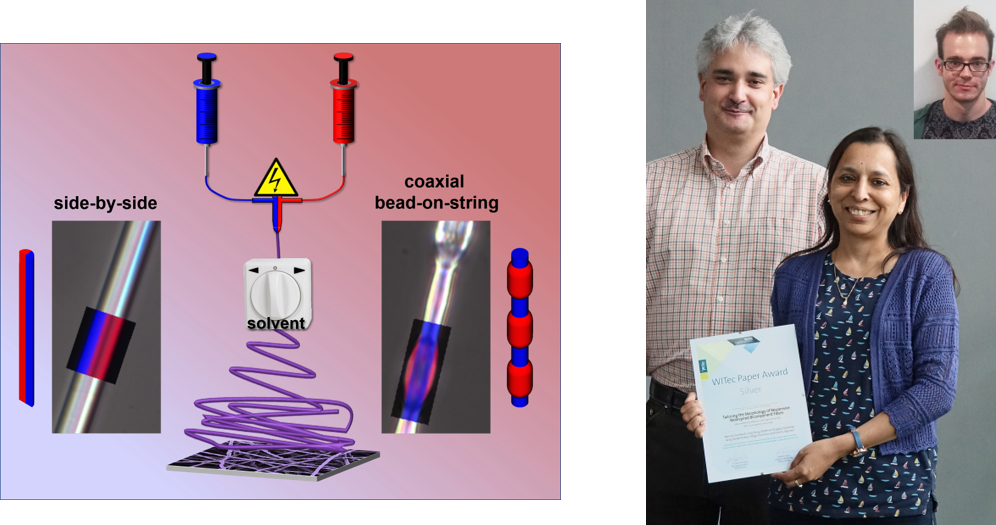
2018 WITec Paper Award for Outstanding Scientific Publications
Our work on “Tailoring the morphology of responsive bioinspired bicomponent fibers”, published in Macromol. Mater. Eng. 2018, 303, 1700248 (DOI. 10.1002/mame.201700248), received the WITec Silver Paper Award 2018. Mimicking biological structures with interesting functional features is a thriving field of research. In our work we were inspired by biological fibers and developed new fibers with distinct structures, utilizing side-by-side electrospinning of a thermo-responsive polymer and a methacrylate-based copolymer. By changing the spinning solvents the fiber morphology could be easily switched between side-by-side and coaxial bead-on-string fibers, as proven by correlative Raman imaging, atomic force microscopy and scanning electron microscopy.
https://www.imaging-git.com/news/2018-witec-paper-award
http://www.chemie.de/news/1155414/witec-paper-award-2018-vergeben.html
http://www.analytica-world.com/de/news/1155414/witec-paper-award-2018-vergeben.html
https://www.analytik-news.de/Presse/2018/333.html
http://www.newslocker.com/de-de/branche/chemie/witec-paper-award-2018-vergeben/view/
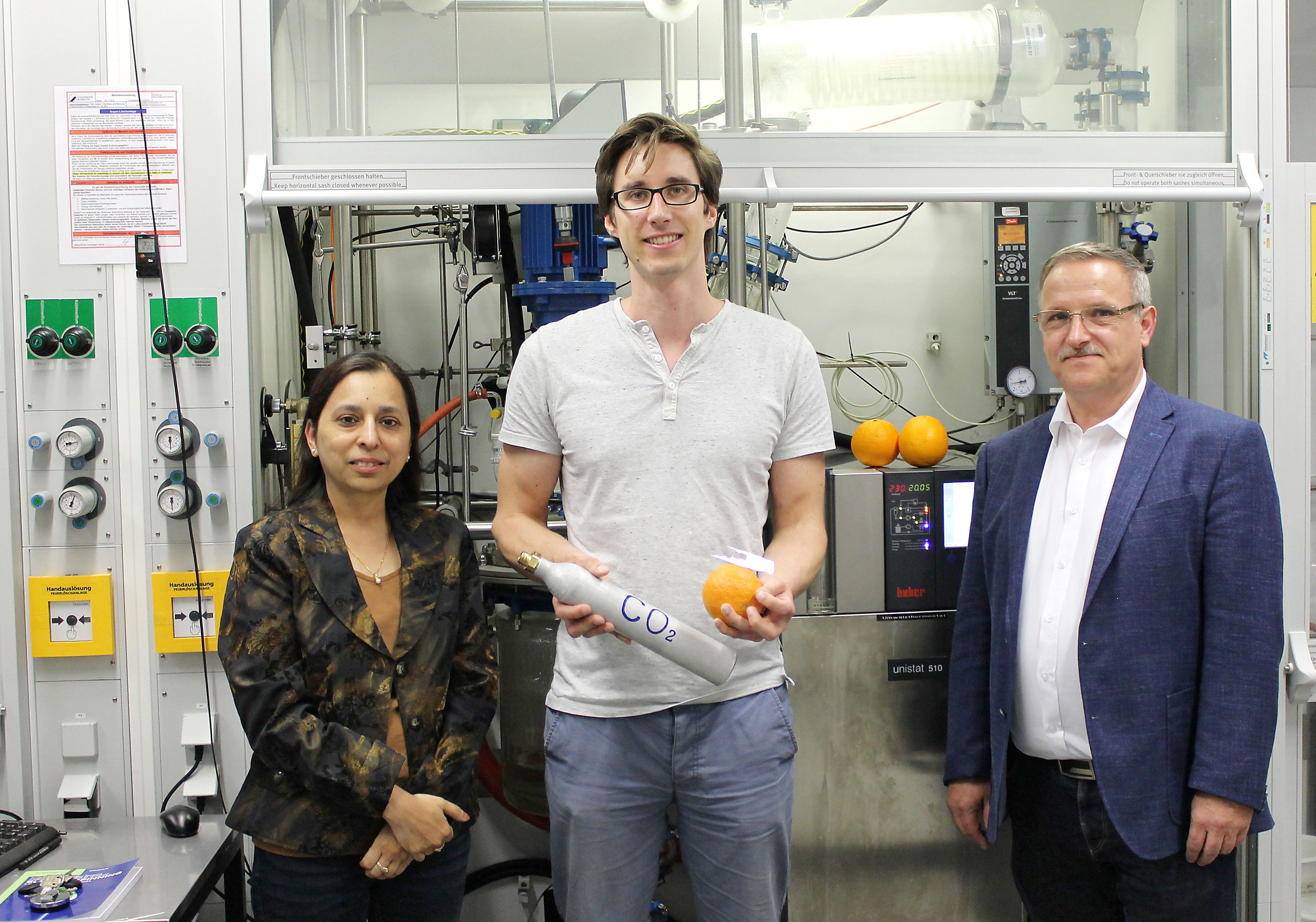
Man nehme Orangenschalen, entziehe ihnen den Naturstoff Limonen, oxidiere ihn und verbinde ihn mit Kohlendioxid: Und schon hat man einen biobasierten Kunststoff, aus dem sich ohne hohe Kosten umweltfreundliche Funktionsmaterialien für verschiedenste industrielle Anwendungen herstellen lassen. ‚PLimC‘ ist der Name dieses grünen Alleskönners, der es erstmals ermöglicht, allein auf der Basis nachwachsender Rohstoffe ein breites Spektrum leistungsstarker Kunststoffe herzustellen. Dies hat jetzt ein Forschungsteam an der Universität Bayreuth herausgefunden, das seine Ergebnisse im Wissenschaftsmagazin ‚Nature Communications‘ vorstellt.
Pressemitteilung:
Ein grüner Alleskönner aus Orangenschalen und Kohlendioxid (Universität Bayreuth)
Tages-/Wochenzeitungen:
Aus Orangenschalen wird Kunststoff (Nordbayerischer Kurier, 24.06.2016)
Studium in Bayreuth: Ein bisschen USA in Oberfranken (Süddeutsche Zeitung, 03.07.2016)
Online-Portale:
Orange Schale, grüner Kern (kunststoffe.de, 01.07.2016)
Biobasiertes Polycarbonat als Grundstoff für Funktionsmaterialien (Analytik News, 23.06.2016)
Plastics made from orange peel and CO2 (Materials Views, 22.06.2016)
Do Citrus Fruits make the Best Thermoplastic Polymers (blog.spotchemi.com, 21.06.2016)
Ein grüner Alleskönner aus Orangenschalen und Kohlendioxid (chemie.de, 17.06.2016)
Umweltfreundlicher Kunststoff - Polymer aus Orangenschalen und CO2 (LABOonline, 16.06.2016)
Ein grüner Alleskönner aus Orangenschalen und Kohlendioxid (innovations report, 16.06.2016)
Ein grüner Alleskönner aus Orangenschalen und Kohlendioxid (idw-online.de, 15.06.2016)
Ein grüner Alleskönner aus Orangenschalen und Kohlendioxid (juraforum.de, 15.06.2016)
Sonstige:
Plastik aus Orangenschalen (NDR Info - Logo - Das Wissenschaftsmagazin, 01.07.2016)
To Leach or not to Leach – Antimicrobial Polymer Materials
Antibiotic-resistant bacteria are a challenging threat to human life, especially in healthcare institutions. Since antibiotic weapons have become less effective due to fast evolving resistance mechanisms in the last decades, new antimicrobial strategies and materials beyond antibiotics are needed to prevent infections associated with medical devices, especially for indwelling devices. Bacterial colonization and growth on those devices lead to often life threatening infection development in the patient’s body.
Link
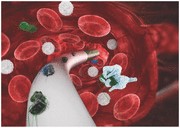
First and second generations of antimicrobial polymers were based on antimicrobial systems releasing antimicrobials from the device into the surrounding tissue to prevent bacterial colonization and growth on the device. Although many of these materials demonstrated good antimicrobial efficacy, these leaching additives are also often associated with negative side effects, such as development of resistant bacteria due to decreasing local concentrations of the additive or life threatening anaphylaxis due to a systemic release. Therefore, new developments with non-leaching antimicrobials, which reduce those risks and side effects, came to the center of attention. Here, only the surface is locally protected by a non-consumptive antimicrobial maintaining the antimicrobial efficacy of the device surface over time.
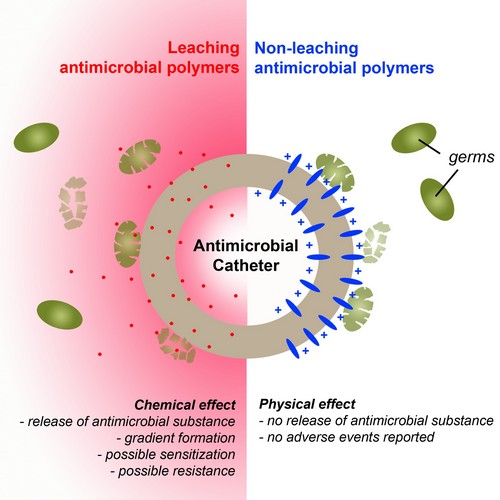
In their current work, Bruenke et. al. have presented the first direct head-to-head comparison of antimicrobial efficacy between leaching and non-leaching antimicrobial materials by using central venous catheters (CVCs) as a clinically relevant model. Catheter-associated infections can develop rapidly into systemic bacterial infections in daily clinical life. The results of this study demonstrated equivalent antimicrobial efficacy of non-leaching CVCs compared to conventional leaching CVC-systems, protecting the device surface from bacterial colonization. Testing was performed against 7 different germs typically associated with CVC-related infections, including the most prominent bacteria Staphylococcus epidermidis and Staphylococcus aureus and also multi-resistant variants. These data represent an initial step to new non-leaching antimicrobial polymers and products, in which problems associated with leaching materials, such as release of bio-active substances, loss of antimicrobial activity and health risks due to biocide leaching, can be minimized. The applicability of these non-leaching antimicrobial materials to other polymer types and materials provides a potent new strategy to fight against device-associated multidrug infections.
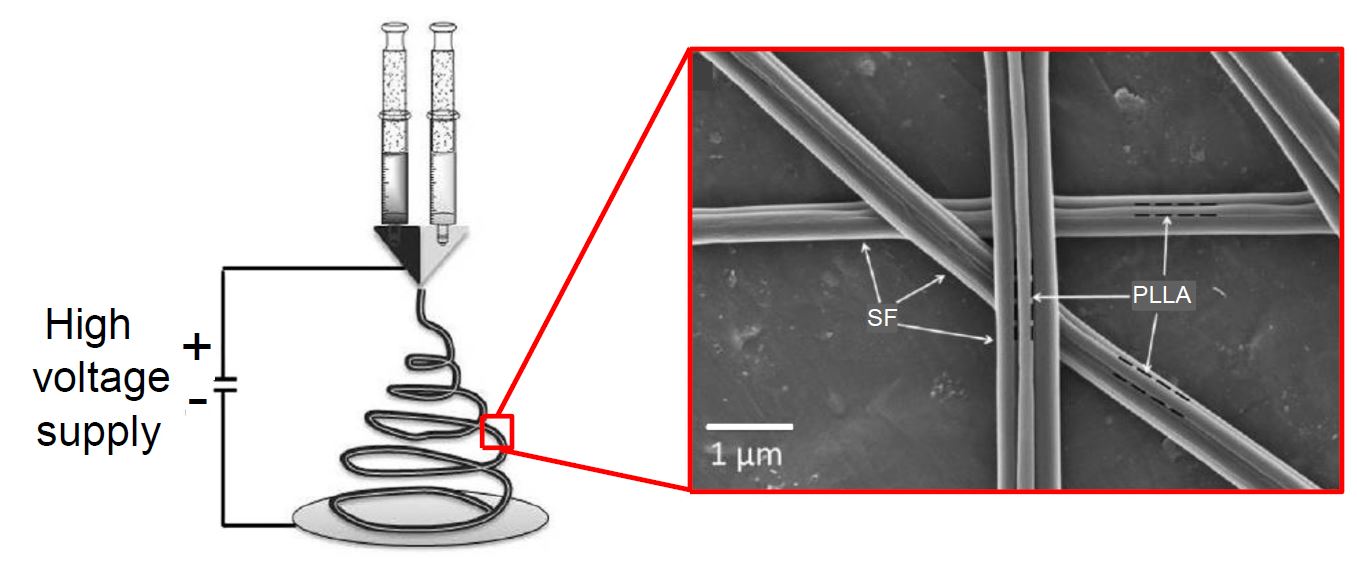
Tailoring” Silk: Hybrid Fibers for Next Generation Implants
A new study from Prof. Seema Agarwal and her colleagues from University of Bayreuth, Germany, shows that mechanical properties of Bombyx mori silk fibroin can be tuned by coupling it with another biocompatible polymer for further implementation in tissue engineering. Remarkably hybrid fibers can be processed without affecting the surface morphology of silk fibroin, the new study argues.
Link
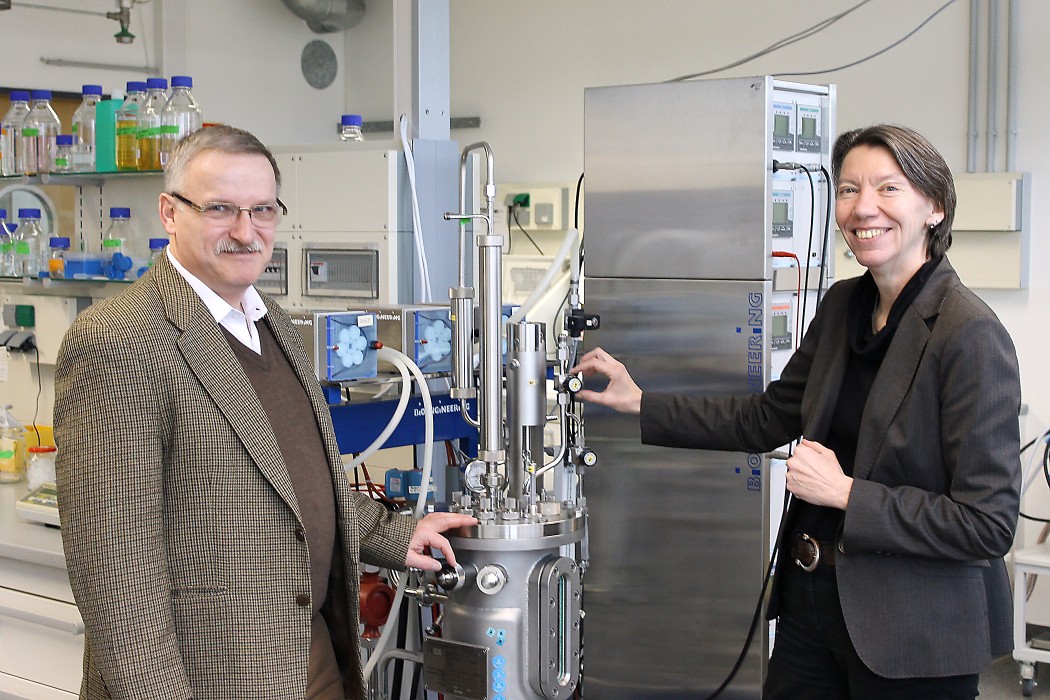
Künstliche Biofilme für ressourcenschonende Biotechnologie
Im neuen bayerischen Projektverbund BayBiotech kooperieren Bioprozesstechnik und Makromolekulare Chemie an der Universität Bayreuth, um ein innovatives Konzept für künstliche Biofilme zu entwickeln. Deren Potenziale sollen in unterschiedlichen Bereichen der Industrie systematisch genutzt werden können – zum Beispiel in der Energietechnik, der Umwelttechnik oder der Pharmazie.
Link
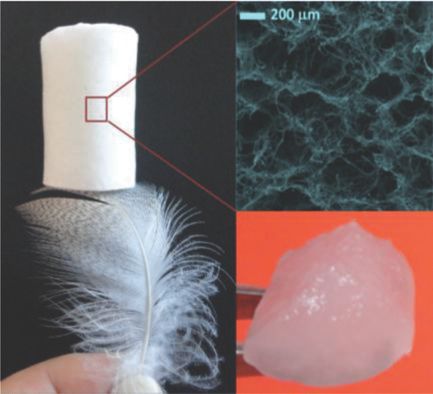
Ultralight Soft Polymer Sponges
Researchers from Bayreuth University (Germany) have developed new sponges made of short fibers of a polyacrylate-based co-polymer. These sponges are very light (density as low as 2.72 mg/cm3, light a bird feather), highly porous (porosity of 99.6 %), and bendable/compressible. Science can use these new sponges for environment remediation (oil absorption) and tissue engineering (cellular growth).

